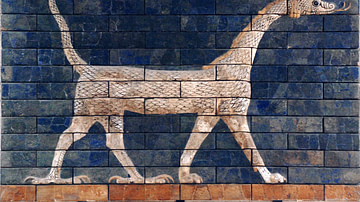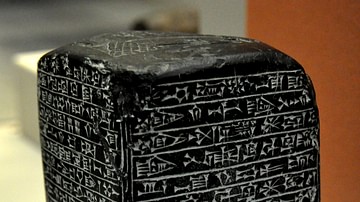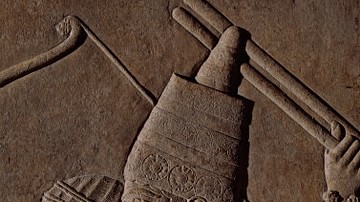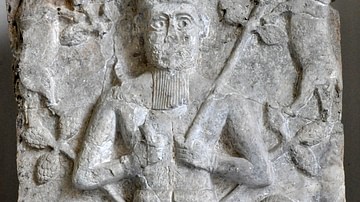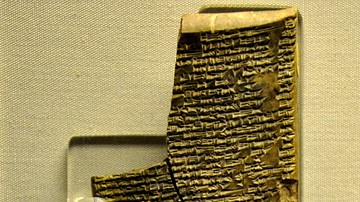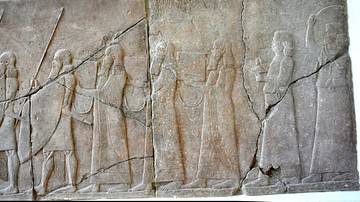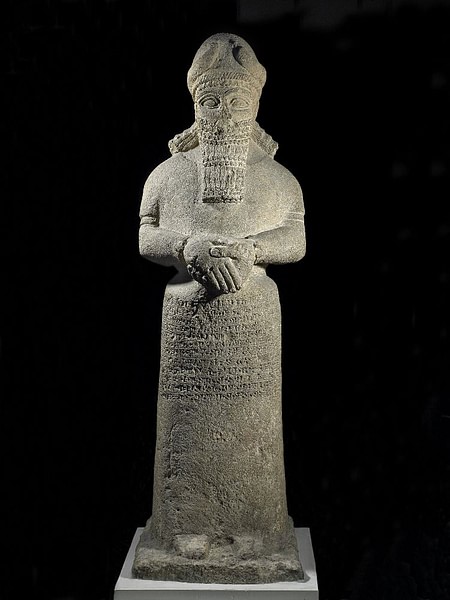
Nabu (sometimes known as Tutu) is the Babylonian god of wisdom, learning, prophecy, scribes, and writing and was also responsible for the abundant harvest and all growing things. His name means "the Announcer" which refers to his prophetic and creative powers in calling forth words, the harvest and other plant life, and the visions of prophecies.
His wife was Tashmit (also known as Tasmetu) and, later, Nanaya who was originally the divine consort of the Sumerian god Muati who became syncretized with Nabu. Nabu himself was developed from the earlier Sumerian goddess of writing and accounts, Nisaba (also known as Nidaba, Nissaba), who is attested to by the Early Dynastic Period (2900-2334 BCE). Sumerian hymns and other compositions, which concluded with the ritual phrase "Praise be to Nisaba!" became the paradigm for later Babylonian works ending with "Praise be to Nabu!"
From these early Sumerian origins, Nabu became increasingly popular during the Old Babylonian Period (2000-1600 BCE) and, particularly, in the reign of King Hammurabi (1792-1750 BCE) when, generally, male deities were elevated in Mesopotamia at the expense of older goddesses. In some myths, Nisaba is Nabu's wife and divine assistant in keeping the records and maintaining the library of the gods (much in the same way as the goddess Seshat worked with Thoth in Egypt). Originally regarded as the vizier and scribe of the god Marduk, following the Kassite Period (c. 1595 BCE) Nabu was regularly depicted as Marduk's son and almost equal to him in power.
His symbol was a wedge-shaped cuneiform mark or a stylus at rest upon a writing tablet, but he was also depicted as a bearded man in royal garb, holding a stylus, standing on the back of a snake-dragon (known as the Mushussu Dragon, a powerful protective spirit associated with Marduk and other gods and included in images on the Ishtar Gate). Nabu was honored as the son of Marduk, king of the gods and patron of Babylon, and grandson of Enki (also known as Ea), the god of wisdom.
After Marduk, Nabu was the most important god of the Babylonians and became so popular he was adopted by the Assyrians and known as the son of their god Ashur/Assur. Even after the fall of the Assyrian Empire in 612 BCE, Nabu - unlike many of the other Assyrian gods - continued to be worshiped until at least the 2nd century CE. His cult center was at Borsippa, near Babylon, and among his many important duties was traveling to the latter city to visit his father during the Akitu Festival marking the beginning of the New Year.
Nabu was associated with the goddess Nisaba by the Sumerians, and the god Thoth by the Egyptians, Apollo by the Greeks, and Mercury by the Romans. He is referred to as Nebo in the Bible, where he is mentioned with Marduk (called "Bel") in Isaiah 46:1-2. Mount Nebo, the site from which Moses looked down upon the promised land and where, according to legend, he is buried, takes its name from Nabu. Among the many gods of Mesopotamia, Nabu became the most prominent, outlasting even the great Marduk in the memory of the people.
The Power of Nabu
Writing was invented in Mesopotamia by the Sumerians c. 3500 BCE, known as cuneiform, and consisting of wedge-shaped marks made in wet clay which was then set to dry. Although this writing system most likely developed due to trade, and the need to send messages over long distances, it was considered (as it was in Egypt) a gift of the gods and, primarily, of Nabu. Scholar E. A. Wallis Budge writes:
He was endowed with great wisdom, like his father; and he acted as scribe to the gods; he had charge of the Tablet of Fate of the gods and had the power of prolonging the days of men. Like the Egyptian Thoth, his eyes travelled over the circuit of the heavens and over all the earth. He was the personification of knowledge and, as a god of vegetation, he caused the earth to produce abundant crops. (85)
Nabu's cult center at Borsippa (referred to as a Second Babylon) was almost as important as the Esagila, the temple-ziggurat of Marduk, at Babylon. Priests of Nabu cared for the god's statue there, operated the temple complex, and were highly respected. The written word was held in such high esteem that, naturally, the patron god of writing was regarded in the same way and so were his representatives. Nabu was so important to the Babylonians that he featured dramatically in their Akitu Festival, arguably the most important the city celebrated, to honor the gods and the harvest at the beginning of each new year.
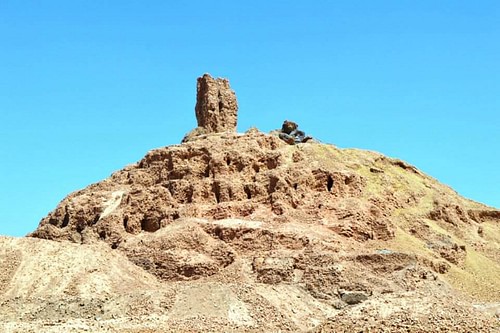
Nabu & the Akitu Festival
The Mesopotamians celebrated many festivals in honor of their gods, but the most important was the Akitu Festival. The celebration was observed, with varying rituals, all over the region. Scholar Stephen Bertman notes:
In some communities, like Babylon, the ceremonies were conducted once a year immediately after the barley harvest in March at the time of the spring equinox (barley was Mesopotamian's chief grain). In other communities, like Ur, there were two celebrations a year, one at the time of the harvest and the other in September when new seed was sown. Because the Mesopotamians looked upon the spring equinox as the beginning of their year, the Harvest Akitu was also a New Year's holiday and a time of added celebration. (130)
The festival lasted for twelve days, with the first six devoted to religious observances by the priests of Marduk at Babylon, and the last a grand public event involving the procession which carried Marduk's statue through the streets of Babylon to a sanctuary outside the city's walls. The Akitu Festival followed, roughly, the following order, and Nabu played a pivotal role in the observances:
Day One: The priests prepared Marduk's sanctuary at Babylon while others did the same for Nabu's temple at Borsippa. Little information is available on the specifics of what this would have entailed.
Day Two: The high priest of Marduk dedicated himself to the god in a renewal ceremony and prayed for Marduk's continued protection of the city while simultaneously thanking him for his gifts.
Day Three: The high priest at Babylon presided over a ceremony in which two dolls were made out of wood which represented the human worshippers of Nabu. These figures were probably fashioned as male and female, although details of the actual figures are not known.
Day Four: While the high priest and lesser clergy prayed to Marduk, the king of the city left for Borsippa to accompany the statue of Nabu to Babylon. While the king was on his journey, the high priest paid respect to Marduk and his divine consort Sarpanitum and blessed the temple and the city. Toward evening, the priest would recite the Enuma Elish, the story of creation which relates how Marduk became the king of the gods, defeated the forces of chaos, and created human beings.
Day Five: While the priests of Marduk and Nabu ritually cleansed the temple, temple complex, and shrine of Nabu, the high priest conferred with the statues of Marduk and Sarpanitum, honoring both in prayer and meditation. When the temples were cleansed, the shrine of Nabu was covered with a canopy of gold and the populace awaited the return of their king with the statue of Nabu. At this point, as Bertman writes:
Then followed a dramatic ceremony: the high priest divested the king of his royal insignia, slapped his face, and forced him to kneel before the god's holy image - an act of humbling debasement that asserted the power of church over state, of god over man. On his knees, the king made confession, swearing that he had not abused the authority entrusted to him and had not sinfully forsaken the interests of Babylon, its people, and its god. In its negative formulation ("I have not...") this confession is reminiscent of the "Negative Confession" found in the Egyptian Book of the Dead by which souls sought to gain entry into paradise, and also of the biblical Ten Commandments, where were also cast in negative terms ("Thou shalt not..."). At the conclusion of the royal confession, the high priest again slapped the face of the king until tears flowed from his eyes, a sign of his genuine contrition. (131)
After this ceremony, the king joined the priests in praying to the gods and sacrifices were made to the planet Mercury, the star of Marduk (also associated with Nabu). The statue of Nabu was placed in its shrine, and the evening ended in prayer throughout the city.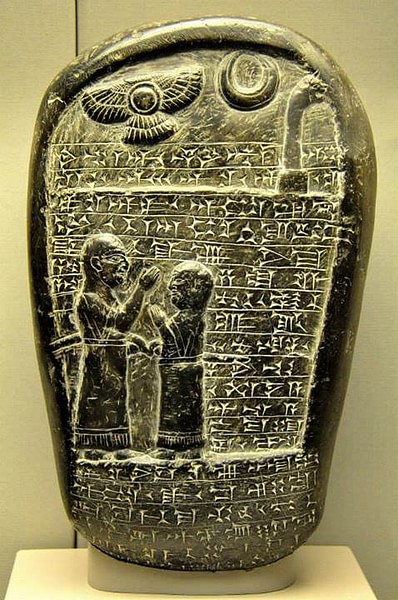
Days Seven and Eight: The king "took the hand" of the statue of Marduk, thus dedicating himself to the god's will, and led him out of his temple into the city. This act began the best-known aspect of the Akitu Festival as people thronged the streets and followed the statue of the god as it processed through the avenues and over to the Shrine of Destinies near Nabu's sanctuary. Nabu was then called upon to give his prophecy concerning the king and the coming year, and this was recorded by the priests. The statues of Marduk, Nabu, and all the other gods were positioned to honor the king, and at this point, the sacred marriage ritual may have been observed in which the king had sex with a priestess representing the goddess Inanna. Whether the sacred marriage was observed by the actual act of sexual intercourse or simply a ritual simulation is unclear. Following the ritual, the procession began again carrying Marduk out of the city to his shrine at the temple known as bit-Akitu, which was filled with flowers and other plants and ringed by a large public park.
Days Nine and Ten: The great banquet of the Akitu Festival was held in the park with the state providing food, drink, and entertainment.
Day Eleven: The statue of Marduk, accompanied by the other gods, was brought back into the city and stopped at Nabu's shrine. Here the prophecy which had been given on Day Seven was read aloud to the people, and afterwards, a closing ceremony was observed by the priests and nobility, including the dignitaries from other cities.
Day Twelve: Public closing ceremonies were observed surrounding Nabu. His statue was then taken from its shrine and began the short trip back to Borsippa by ship. As Nabu left the city, the statues of the other gods left for their respective homes.
The festival could not be observed if the statue of Marduk was not present in the city, which happened a number of times when it was taken after conquest by the Hittites, Assyrians, and Elamites. Marduk's 'travels' outside the city during these times are recorded in the document known as The Marduk Prophecy. The statue of Nabu, however, was equally important, and the Akitu Chronicles note the years that Nabu remained in Borsippa because Marduk was not in Babylon.
Nabu's Legacy
Although closely tied to the city of Babylon, Nabu became so popular in Mesopotamia that he was adopted by the Assyrians as the son of their supreme god Ashur. Ashur was considered so powerful, and his worship became so widespread, that it became a kind of monotheism. Ashur and his son Nabu were available to all the people of the Assyrian Empire everywhere, and this established Nabu as an important deity outside of Mesopotamia.
The Assyrians were regarded as harsh overlords by their non-Assyrian subjects, but still, their gods were honored in all the territories and by many different ethnicities. Marduk had also been adopted by the Assyrians but retained the political associations with Babylon he had acquired over the years; no such connection attached itself to Nabu.
When the Assyrian Empire fell in 612 BCE, the statues of the gods, especially Ashur and Marduk who were closely associated with the empire, were pulled down by the forces of the Medes, Babylonians, Persians, and others, but Nabu's statue was honored. Scholar Gwendolyn Leick writes how Nabu "endured when other gods, who had been more closely identified with political power (e.g. Marduk) had lost popularity" (123). The cities of Assyria, their temples, and the statues of their gods were razed after the empire fell, but worship of Nabu continued throughout Mesopotamia and spread to Egypt, Anatolia, and Syria.
By the time of the reign of Augustus Caesar (27 BCE-14 CE), Nabu was known in Greece and Rome, where he was identified with Apollo and Mercury and continued his traditional duties in presiding over the written word and encouraging the work of poets and writers. Whether he inspired the images of the later literary gods of other cultures is debated, but, since he came first, it is probable that he did.
The worship of a deity dedicated to knowledge and writing highlighted the value of the written word and encouraged writers to consider their work a holy calling by their patron god. Veneration of Nabu established writing as more than simply a utilitarian craft for communication but as an art form which helped to preserve the present for the future.
